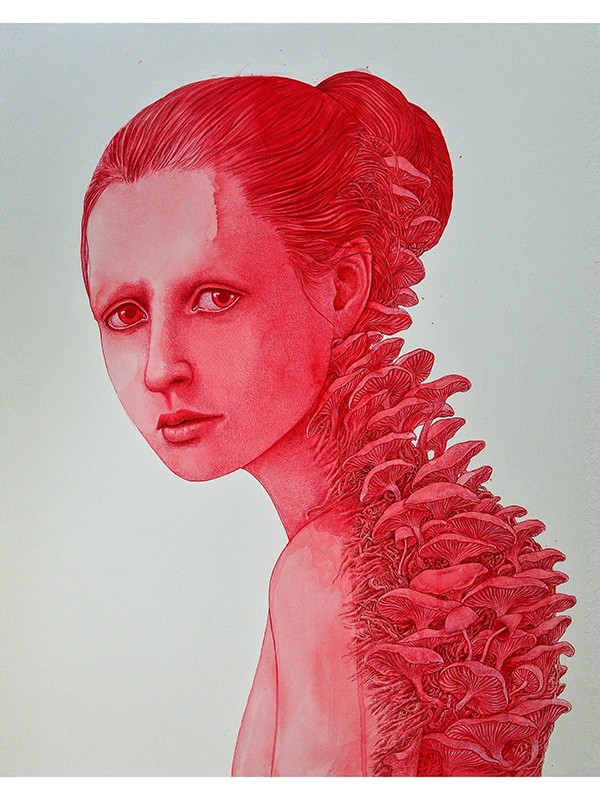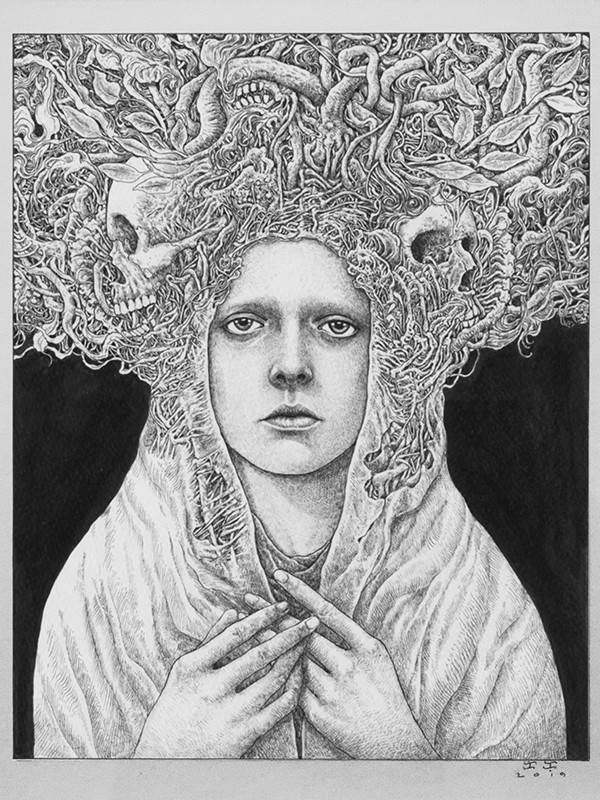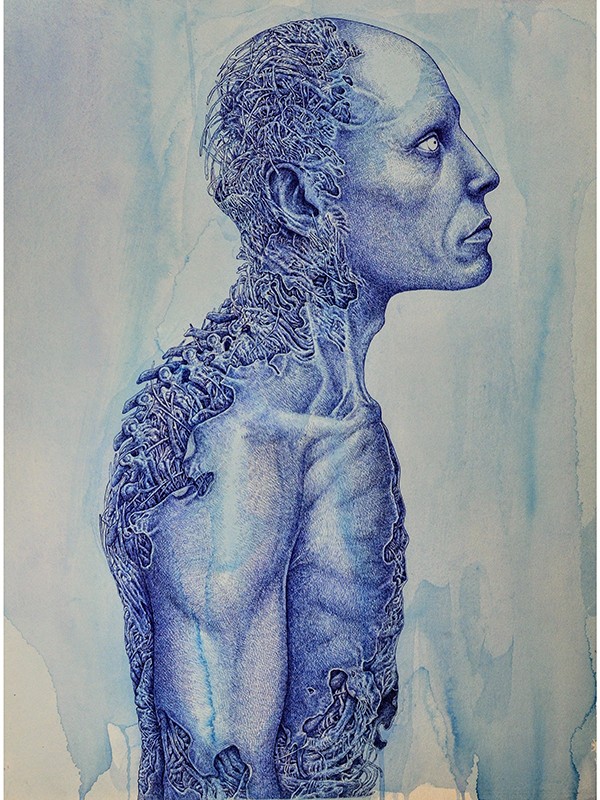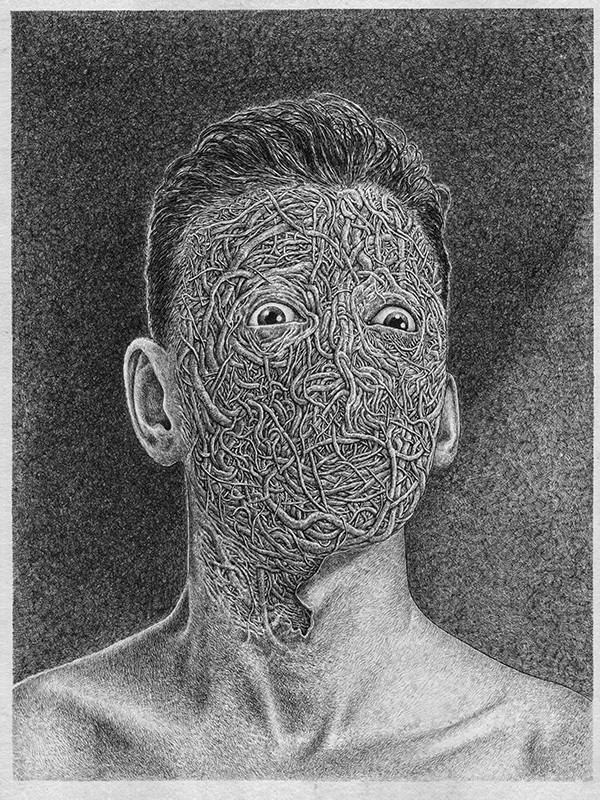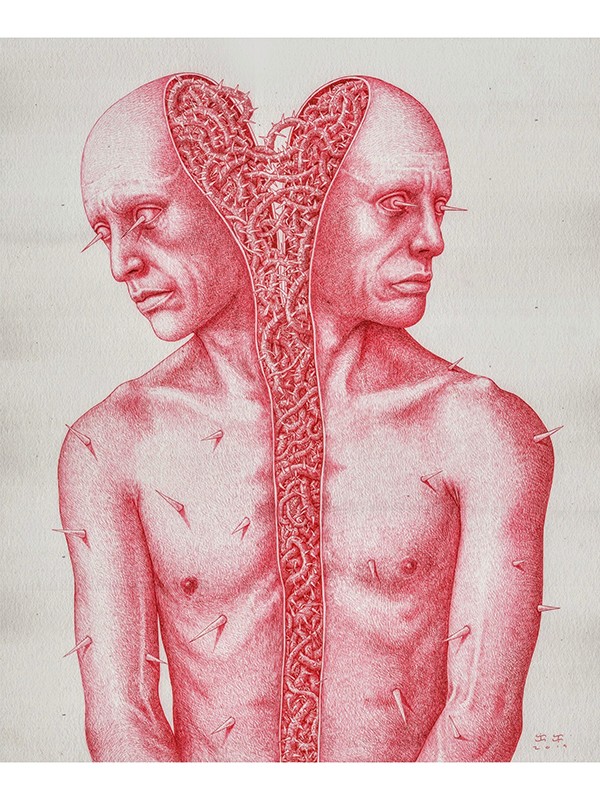"Fear" will always be a big word for me. It encapsulates more than just the creepy crawlies or the spooky poltergeists but also the anxieties and demons that reside deep down our consciousness. It's a word that carries with it thousands of stories and horrifying images of what had been, what could be, and what is. There is no end to what fear can make you feel but most of the time, intuitions keep you at a standstill when encountering fear. It paralyzes you to a point of silence and later, a realization. This is the type of fear enforced by the works of Filipino artist Kiko Capile—distraught and personal.
Carnival of Souls on Canvas
"I can say that macabre art is my core," Capile shares. There is no concrete reason why Capile does such art in intricate lines all tied up to create one grotesque creation. The images are terrifying but they don't come off as those that scare you. "I have no specific reasons kung bakit yun ang themes ko. Even in college, laging 'yon ang themes ng gawa ko. Hindi ako naging interested sa mga “pretty pictures” or yung may mga positive and uplifting themes. Madalas nabo-bore when I'm required to do those themes sa mga plates."1 But just like any artist, Kiko Capile delivers. His works are as real as the images shown on his current artworks, stripped off of pretentions and wrapped in raw fleshly breadth.
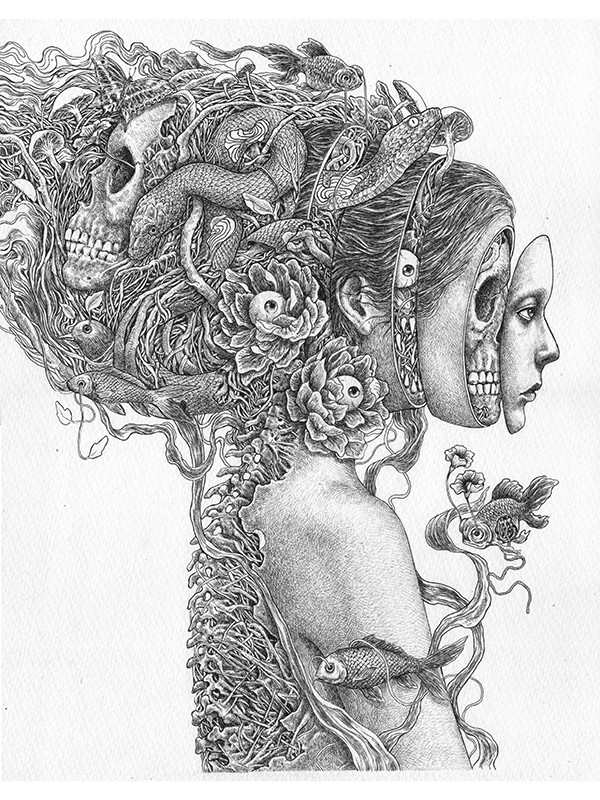
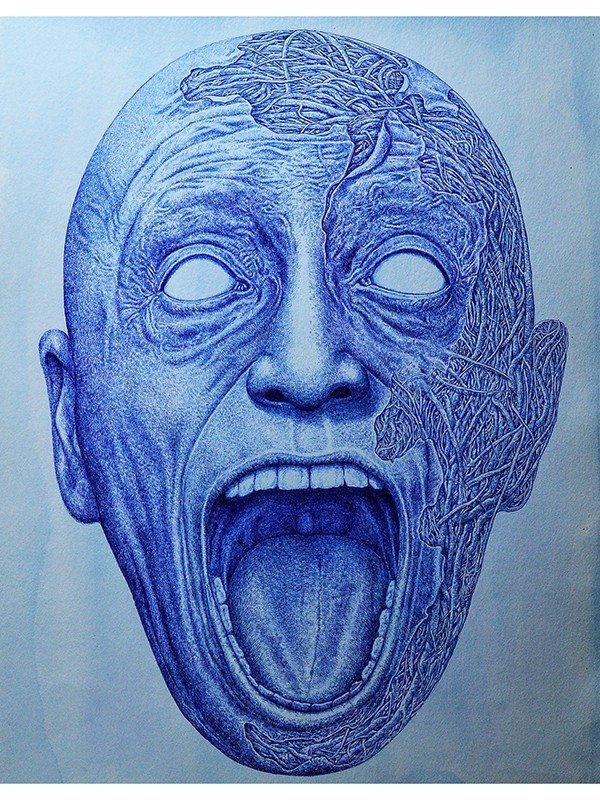
Perhaps, what keeps you staring when you look at his works are the fine details he incorporates in his works—like how life blooms on what appears to be an infant out cold. And perhaps this is why Capile found this theme more interesting than pretty pictures; the fine details that make up these pictures are what allows him to explore more than just himself but every other man who views his works. "I always try to represent what's inside ng tao or character ng gawa ko,"2 the artist adds.
"Reoccurring yung monstrosity, frailty, destructive tendency, growth and decay, and pain and hatred represented by human figures na decaying—madalas splitting to half or in destruction phase."3 And it could be that these images are who we are—self-destructing and tormented through frailty.
Yet these creations don't just come to Capile like an epiphany. Though just like any artist, his mind is always pre-occupied with what his next artwork would be like. "Kapag may biglang mag-click sa isip ko, ginagawan ko kaagad ng thumbnail sketch, para hindi mawala yung idea,"4 he states to which he emphasizes the importance of thumbnail sketches. "It's like a visual diary of ideas na pwede mo balikan at gamitin kapag walang pumapasok na ideas."5 Capile's process is not so different from other artists. He draws inspiration from movies, music videos, graphic novels, comic books, old masters' works, other contemporary artists' works, and illustrations. Sometimes though, Capile admits that inspirations do come from unexpected sources. From an inspiration, the artist proceeds to do a sketch that's proportionate to the artwork's final size. "Then I scale them para sa final output whether on canvas or on paper. I also do digital studies then sketch it to add all the elements of the drawing."6
“I always try to represent what's inside ng tao or character ng gawa ko.”
But what makes Kiko's works differently despite the similarities in the process that he shares with other artists is the fact that he knows how the aberrance in his works leaves an impact on whoever views them. "I think doing dark themes is exciting. It creates a lasting image sa utak when you see one. Mas madalas, it stands out that it draws attention. One proof is when I post darker-themed artworks on my Instagram account, it usually gets more appreciation than the more aesthetically pleasing artwork that I post."7 This data alone says a lot about how the digital age works. Aside from the fact that almost everyone is online these days, it's certain that the internet is one of the places where we can share a side to us or show appreciation to things we don't usually talk about in real life. The internet is a free space for everybody and Capile's works allow you to relate to each work without the fear of being judged.
Realities of Artistry
As surreal as his works may go, Kiko Capile knows a lot about the reality that artists face in today's economy. While it's true that the art scene continues to flourish but it's almost impossible for artists to sustain their passion without having to dread early morning commutes, deadlines, and corporate visions. Capile was employed for 15 years before he quit to become a full-time artist, a decision that was monumental not only for his career but also for the rest of his existence.
"Quiting my day job has to be the hardest decision I’ve made. In fact, it took me six months to make the decision," he shares. "Practical na tao kasi ako kaya I don’t believe in "follow your passion" kasi I have a family to provide for. If only I have an ideal work environment, baka pinagsabay ko."8 It isn't the first time that we've heard stories like these when artists have to sacrifice to be able to do what they love doing. Some artists have to quit their passion instead to be able to survive the challenges of everyday life.
With this, Kiko has a piece of advice to artists with day jobs. "Keep your day job as long as you can or find less time and creativity-consuming job while finding your way into the art scene. You need funds to support your art and also It lessens the pressure of depending on your livelihood in your art. That way you will not resort to creating art where your main goal is to sell."
It's only been a year since Capile penetrated into the industry, but it feels like he knows how the tides have changed in the local and international scene throughout the years. But just like anyone who's new to any industry, he has fears of his own. "Baka sobrang ma-saturate yung art scene. I think it peaked the last couple of years; some say it is starting to slow down."9 But with these fears, Capile has come up with an idea. "For me, for an artist to always be relevant, dapat may niche ka na sa'yo lang at ikaw lang nag-o-occupy. Sa dami ng talented artists sa scene, mahirap ang mapansin lalo na kung ang gagawin mo ay parehas din ng nakararami. Prevalent sa local art scene natin 'yon eh. Ang dami magkakaparehas ng style and techniques—even the themes—pero kapag na-outgrow ng mga batang artist natin yung phase na 'yon eventually mas maraming local artist natin ang makaka-penetrate globally."10
Kiko Capile is an artist and a human being and in his works, we find some kind of solace that maybe we are not alone at being the weird one out there. We're not the only people with skeletons in our closet.
1 "I have no specific reasons why that's the theme of my works. Even in college, that's the theme I usually do. I was never interested interested on “pretty pictures” or works with positive and uplifting themes. I usually get bored when I'm required to do those themes on plates."
2 "I always try to represent what's inside the people or characters I create."
3 "Monstrosity, frailty, destructive tendency, growth and decay, and pain and hatred represented by human figures that are decaying are reoccurring [in my works]—usually, splitting to hald or in destruction phase."
4 "If something suddenly clicked in my head, I immediately do a thumbnail sketch so I won't lose the idea."
5 "It's like a visual diary of ideas I can get back to when no ideas come up."
6 "Then I scale them for the final output, whether on canvas or on paper. I also do digital studies then sketch it to add all the elements of the drawing."
7 "I think doing dark themes is exciting. It creates a lasting image in the mind when you see one. Usually, it stands out that it draws attention. One proof is when I post darker-themed artworks on my Instagram account, it usually gets more appreciation than the more aesthetically pleasing artwork that I post."
8 "I am a practical person so I don’t believe in "follow your passion" because I have a family to provide for. If only I have an ideal work environment, I could have done them simultaneously."
9 "Baka sobrang ma-saturate yung art scene. I think it peaked the last couple of years; some say it is starting to slow down."
10"For me, for an artist to always be relevant, you should always have an exclusive niche. With the many talented artists in the scene, it's hard to be noticed especially if what you do is similar to many others. That's prevalent in our local art scene. A lot of artists have the same styles and techniques—even the themes—but once young artists outgrow that phase, eventually a lot of homegrown artists will be able to penetrate globally."

